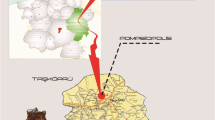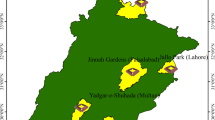Abstract
In recent years, natural areas have become a preferred recreation area for people looking to escape their busy urban lives. The world has become so complicated that people now seek solace in areas of nature. Recreational activities conducted in natural areas, such as Ilgaz Mountain National Park, should be respectful of the environment to ensure balance and no negative environmental impact. This balance should safeguard environmental protection and only be used with the right to establish recreation planning. National parks are protected areas where the most beautiful wonders of nature exist. Thus, urban planning for recreation, and demand for recreation areas, must demonstrate both the potential of recreation resources and the protection of Ilgaz Mountain National Park. Urban open and green spaces have an important function, and in this study, it has been looked at Ilgaz Mountain National Park to examine the current situation. The aim of this study is to ensure the sustainability of natural and cultural resources via an evaluation to reveal the necessary practices and precautions regarding the area’s recreational potential. As a result, Ilgaz Mountain National Park’s recreation potential was found to be 72 %, and thus, it is considered to be an area of high recreation potential.




Similar content being viewed by others
References
Barros, A., Gonnet, J. M., & Pickering, C. M. (2013). Impacts of informal trails on vegetation and soils in the highest protected area in the Southern Hemisphere. Journal of Environmental Management, 127, 50–60. doi:10.1016/j.jenvman.2013.04.030.
Brown, G., & Weber, D. (2011). Public participation GIS: a new method for national park planning. Landscape and Urban Planning, 102(1), 1–15. doi:10.1016/j.landurbplan.2011.03.003.
Calik, F., & Sertbas, K. (2014). Sport and recreation potential analysis of natural parks. Journal of Physical Education and Sport, 14(2), 263–270.
Cengiz, T. (2007). Tourism, an ecological approach in protected areas: Karagöl-Sahara National Park, Turkey. Journal of Environmental Protection and Ecology, 14(3), 260–267. doi:10.1080/13504500709469726.
Cetin, M. (2015a). Consideration of permeable pavement in landscape architecture. Journal of Environmental Protection and Ecology, 16(1), 385–392.
Cetin, M. (2015b). Using GIS analysis to assess urban green space in terms of accessibility: case study in Kutahya. International Journal of Sustainable Development & World Ecology, 22(5), 420–424. doi:10.1080/13504509.2015.1061066.
Cetin, M. (2015c). Evaluation of the sustainable tourism potential of a protected area for landscape planning: a case study of the ancient city of Pompeipolis in Kastamonu. International Journal of Sustainable Development & World Ecology, 22(6), 490–495. doi:10.1080/13504509.2015.1081651.
Cetin, M. (2015d). Determining the bioclimatic comfort in Kastamonu city. Environmental Monitoring & Assessment, 187(10), 640. doi:10.1007/s10661-015-4861-3.
Cheung, L. T. O., & Jim, C. Y. (2014). Expectations and willingness-to-pay for ecotourism services in Hong Kong’s conservation areas. International Journal of Sustainable Development & World Ecology, 21(2), 149–159. doi:10.1080/13504509.2013.859183.
Chhetri, P., & Arrowsmith, C. (2008). GIS-based modeling of recreational potential of nature-based tourist destinations. Tourism Geographies: An International Journal of Tourism Space, Place and Environment, 10(2), 233–257. doi:10.1080/14616680802000089.
D’Antonio, A. L. (2010). Recreation resource impacts in the bear lake road corridor of rocky Mountain National Park, Colorado, USA: an assessment of resource conditions and visitor perceptions. Logan, UTAH, USA: Utah State University, Master dissertation.
D'Antonio, A., Monz, C., Newman, P., Lawson, S., & Taff, D. (2013). Enhancing the utility of visitor impact assessment in parks and protected areas: a combined social–ecological approach. Journal of Environmental Management, 124, 72–81. doi:10.1016/j.jenvman.2013.03.036.
Duzgunes, E., & Demirel, O. (2013). Determining the tourism potential of the Altındere Valley National Park (Trabzon/Turkey) with respect to its conservation value. International Journal of Sustainable Development & World Ecology, 20(4), 358–368. doi:10.1080/13504509.2013.777861.
Geneletti, D., & Dawa, D. (2009). Environmental impact assessment of mountain tourism in developing regions: a study in Ladakh, Indian Himalaya. Environmental Impact Assessment Review, 29(4), 229–242. doi:10.1016/j.eiar.2009.01.003.
Goonan, K. A. (2009). Protecting natural resources and the visitor experience on mountain summits in the Northern Forest: a framework for management. Master Dissertation. Burlington, VT: University of Vermont.
Gulez, S. (1990). An evaluation method for determination of inside of forest recreation potential. Istanbul University. Journal of Faculty of Forestry, 40(2), 132–147.
Kastamonu. (2015). National Parks Directorate, Directorate of Kastamonu Ilgaz Mountain National Park. http://bolge10.ormansu.gov.tr/10bolge/AnaSayfa/milliparklarsubemudurlugu/ilgaz.aspx?sflang=tr accessed 12 January 2015.
Kaya, L. G., & Aytekin, A. (2009). Determination of outdoor recreation potential: case of the city of Bartın and its environs, Turkey. Fresenius Environmental Bulletin, 18(8), 1513–1524.
Kaya, L. G., Cetin, M., & Doygun, H. (2009). A holistic approach in analyzing the landscape potential: Porsuk Dam Lake and its environs, Turkey. Fresenius Environmental Bulletin, 18(8), 1525–153.
Kim, M. K., & Daigle, J. J. (2012). Monitoring of vegetation impact due to trampling on Cadillac Mountain summit using high spatial resolution remote sensing data sets. Environmental Management, 50(5), 956–968. doi:10.1007/s00267-012-9905-7.
Kliskey, A. D. (2000). Recreation terrain suitability mapping: a spatially explicit methodology for determining recreation potential for resource use assessment. Landscape and Urban Planning, 52(1), 33–43. doi:10.1016/S0169-2046(00)00111-0.
Maple, L. C., Eagles, P. F. J., & Rolfe, H. (2010). Birdwatchers’ specialisation characteristics and national park tourism planning. Journal of Ecotourism, 9(3), 219–238. doi:10.1080/14724040903370213.
Monz, C. A., Marion, J. L., Goonan, K. A., Manning, R. E., Wimpey, J., & Carr, C. (2010). Assessment and monitoring of recreation impacts and resource conditions on mountain summits: examples from the Northern Forest, USA. Mountain Research and Development, 30(4), 332–343. http://dx.doi.org/10.1659/MRD-JOURNAL-D-09-00078.1.
Ngoka, P. C. (2013). Capacity and levels of utilization of tourism potentials of Yankari and Cross River National Parks—implications for optimistic ecotourism development in Nigeria. African Journal of Hospitality, Tourism and Leisure, 2(4), 1–12.
NP. (2015). National Parks of Turkey 2015. Republic of Turkey. Ministry of forest and water. The general of directorate of nature protection and national parks. http://www.milliparklar.gov.tr/mp/ilgazdagi/index.htm accessed 12 January 2015.
Okelloa, M. M., & Yerian, S. (2009). Tourist satisfaction in relation to attractions and implications for conservation in the protected areas of the Northern Circuit, Tanzania. Journal of Sustainable Tourism, 17(5), 605–625. doi:10.1080/09669580902928450.
TC. (2015). Tourism and Culture. Republic of Turkey. Ministry of Tourism and Culture. Kastamonu directorate of culture and tourism. http://www.kastamonukultur.gov.tr/TR,63883/milli-parklar-ve-korunan-alanlar.html accessed 14 January 2015.
Tomczyk, A. M. (2011). A GIS assessment and modelling of environmental sensitivity of recreational trails: the case of Gorce National Park, Poland. Applied Geography, 31(1), 339–351. doi:10.1016/j.apgeog.2010.07.006.
Topay, M. (2013). Mapping of thermal comfort for outdoor recreation planning using GIS: the case of Isparta Province (Turkey). Turkish Journal of Agriculture and Forestry, 37, 110–120.
Topay, M., & Memluk, Y. (2011). Suitable for recreational area events choice for a new method approach: a case study of Bartin-Uluyayla. Suleyman Demirel University. Journal of Faculty of Forestry, 12(2), 141–147. Isparta.
Zhang, J. T., Xiang, C., & Li, M. (2012). Effects of tourism and topography on vegetation diversity in the subalpine meadows of the Dongling Mountains of Beijing, China. Environmental Management, 49(2), 403–411. doi:10.1007/s00267-011-9786-1.
Author information
Authors and Affiliations
Corresponding author
Rights and permissions
About this article
Cite this article
Cetin, M., Sevik, H. Evaluating the recreation potential of Ilgaz Mountain National Park in Turkey. Environ Monit Assess 188, 52 (2016). https://doi.org/10.1007/s10661-015-5064-7
Received:
Accepted:
Published:
DOI: https://doi.org/10.1007/s10661-015-5064-7




